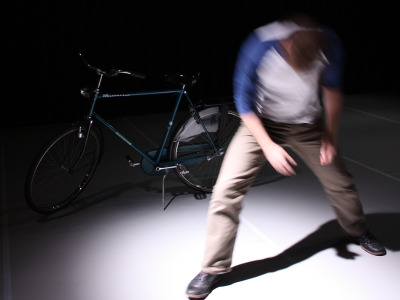Verfluisterd in stilte*
april 16th, 2020Het besluit is genomen om aan de andere kant te staan
Beelden te maken van inzakkende mensen
Gebogen, klaar om te starten
Klaar om te staren, te fluisteren, te dansen, te buigen
Maar waarvoor buig je?
Waar sta je voor klaar?
Wat ontvouw je?
Wat ontvouwt zich voor je voeten?
Een podium voor de man met vragen voor Valerie, voor ons
Over mannelijkheid, over het gebrek van de man
Stelt de vraag, maar luistert niet meer naar antwoorden
Het mannelijk gen is gebrekkig te noemen
Machinaal op te schrijven wat de woorden zijn
Maar niet wat ze betekenen
De houding, verkrampte verhoudingen
En een knip in de vingers vergroot de bühne
Verkleint de ruimte om te vluchten
Uit de wereld waar je invalt
Waar je uit wilt groeien als berkenbomen
Als de asfaltweg naar de horizon
Het pad door de modder
De wereld van de witte muur, witte deur, witte deurpost
Het systeem waar je uit wilt ontsnappen
Dat afgeschaft zal moeten worden, ontvouwt zich
In alledaagse verontschuldigingen en starbucks coffee
Opgewonden gedacht, ongecontroleerd doorgedraaid
Van het uittrekken van kleding tot de mannelijke bevrediging
In een paar seconde fantasie. ‘Mag dit wel?’, denkt de man
Het tuig, het vrouwelijk tuig zet daartegenover
De goten en gaten, om vanuit daar tegen te werken
De maatschappij te verzieken, de man te verzwakken
Het verkrampte verleden, lusteloos aanschouwt in het heden
Radicaal ingezakt verkrampte beelden
Vergezocht, verfluisterd in stilte
* Door Jochem Naafs. Geïnspireerd door SCUM/TUIG door Espen Hjort. Utrecht: Het Huis, 16 oktober 2019
 The Performance Engine will be presented in Studio T on Friday 27th from 7 pm till 9 pm. We will focus on the possibilities of the Performance Engine as a technological memory machine. The Performance Engine (developed by Joris Weijdom and his team) is a system of hard- and software that enables theatre practitioners to improvise with interactive digital media. In several laboratory settings (LAB’S) practitioners have experimented with this setup and used the experience in their work. Currently, Weijdom’s research group at the Utrecht School for the Arts is working on the next phase of implementing so-called Mixed Reality techniques into the context of theatre and performance.
The Performance Engine will be presented in Studio T on Friday 27th from 7 pm till 9 pm. We will focus on the possibilities of the Performance Engine as a technological memory machine. The Performance Engine (developed by Joris Weijdom and his team) is a system of hard- and software that enables theatre practitioners to improvise with interactive digital media. In several laboratory settings (LAB’S) practitioners have experimented with this setup and used the experience in their work. Currently, Weijdom’s research group at the Utrecht School for the Arts is working on the next phase of implementing so-called Mixed Reality techniques into the context of theatre and performance.



 December 5th and 6th
December 5th and 6th